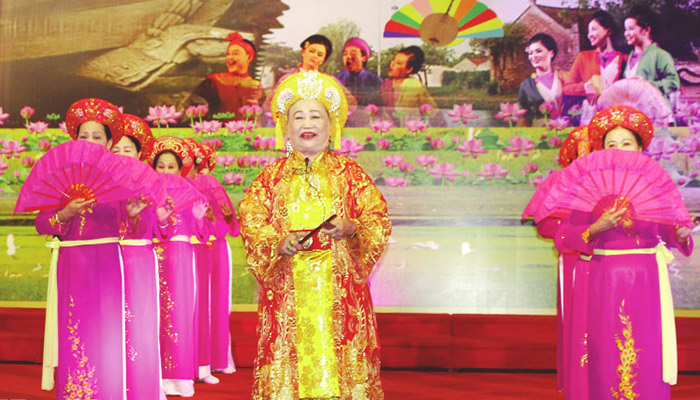Preserving the Traditional Folk Song and Dance of Ha Nam
Ha Nam is a land of peace and harmony, where many artisans devote themselves to various traditional art forms such as “Cheo” singing, “Dam” chanting, “Chau van” ceremonial singing, “Xam” singing, drumming, ... Nowadays, across generations, families of artisans actively preserve and transmit their experiences, nurturing the province's traditional cultural heritage and contributing to the national cultural heritage as a whole.

When it comes to “Dam” chanting, one immediately thinks of a folk singing and dancing form that has existed for nearly 100 years, still retaining its distinctive characteristics of the Thi Son region (Kim Bang).
The story of the origin of "Dam" chanting is well-known among the people of Quyen Son. Legend has it that in the year Ky Dau (1069) when Ly Thuong Kiet led his army to fight the southern invaders, the fleet sailed along the Day River, passing through the Canh Dịch camp (now Quyen Son village), they encountered a severe storm. To avoid the storm, they had to dock their boats at the foot of the mountain, where the violent wind broke the mast and tore the flag, which fluttered to the mountaintop. Sensing something unusual, Ly Thuong Kiet ordered his troops and generals to disembark and conduct rituals to pray for victory to the heavens and the earth. Henceforth, he named the mountain Quyen Son and changed the Canh Dich camp to Quyen Son village.
During that military campaign, Ly Thuong Kiet led the army to a significant victory. On the way back to the capital city, when passing through the old mountainous region, he remembered the prayers he had made in the past, so he ordered the army to stop and set up camp by the bamboo forest, slaughtered oxen and made offerings to the heavens and the earth, and held a celebration to commemorate the victory. Ly Thuong Kiet invited the villagers to join the festivities with the soldiers. He selected young maidens from the village to sing and dance, and sturdy young men to organize boat races. This singing and dancing performance became known as "Dam" chanting, a form of ceremonial singing that praises the heroic feats of defending the country against invaders, celebrates peaceful and happy life, and promotes settlement and prosperity.
To honor Ly Thuong Kiet's contributions, the people revered him as the Village Emperor and built a temple right where he held the victory celebration. This is the Truc temple at the foot of Quyen Son mountain. Every year, during the beginning of spring, the villagers organize a festival from the 1st to the 10th day of the second lunar month, featuring "Dam" chanting performances to commemorate the heroic figure.
From the early days of the first lunar month, when the agricultural work is winding down, the villagers begin to select several dozen young maidens aged 13 to 17 to gather at the home of an elder to practice singing and dancing according to the ritual. Once all the preparations are complete, the elders choose about 16 to 20 of the best singers and dancers to perform at the Trúc temple, where they sing for 10 consecutive days and nights during the temple festival.
.jpg)
"Dam" chanting consists of 38 different melodies. Each melody corresponds to a song, some with multiple verses, some with simple lyrics about specific objects or events, and some incorporating ancient folk verses. During the performance, the elder, who must be a widow or a woman whose husband has passed away, stands in front of the altar in gold or red attire and conducts the rhythm with a pair of bamboo clappers, adjusting the tempo according to the song. In songs that involve dancing, red or white paper fans are used for gestures and decorations, while the fans are tucked into the waistband when not in use. To avoid confusion and mistakes during the performance, the elder usually speaks and performs the motions as a model for the young women to follow.
It's worth noting that Ms. Ram was the one who took "Dam" chanting to promote and perform in 14 countries around the world, including Denmark, Norway, England, Belgium, Germany, and the United States...
Ms. Pham shared, "Now, my older sister is no longer here. But I still hope to have favorable conditions to perform abroad, promoting the beauty and culture of Vietnam." Along with her sister, Ms. Pham was honored by the state with the title of Outstanding Artisan for her contributions to preserving "Dam" chanting and actively passing it on to hundreds of children in her hometown, from one generation to the next. Currently, there are over 30 female students gathered around Ms. Pham, eagerly learning the songs and dances, and serving during the festivals and celebrations.

.jpg)








